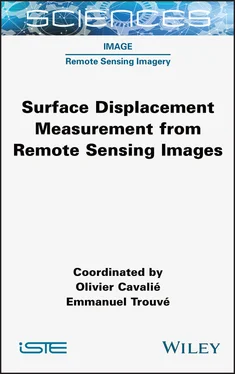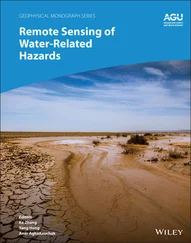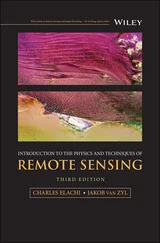– Formosat-2: This satellite has a daily revisit for event/disaster monitoring, thanks to a body-pointing capability of ±45° in roll and pitch.
1.4.2. On-going optical missions
This section presents optical satellites that are still operational and whose data may be used for DEM extraction and ground motion displacement measurement. Their spatial resolution is below 15 m. The list is not exhaustive. The key parameters of the missions are summarized in Tables 1.8and 1.9, and the main characteristics of the instrument are listed in Tables 1.10and 1.11. Some figures are different depending on the web sources and may differ from the real ones in some cases. Swath width and dynamic ranges are given for the highest resolution (mainly panchromatic bands).
During the last 15 years, the main drivers were increases in the spatial resolution and the revisit time. This is conducive to the conception of constellations of agile satellites (simpler, if possible, and smaller). It is possible to observe several evolution patterns for optical satellite missions:
– agility is often the reference: it simplifies the instrument and reduces use of steering mirrors;
– operators reduce the satellite altitude in order to find a compromise between smaller aperture and better spatial resolution. Examples: Cartosat-2C and Cartosat-3A;
– a large aperture is chosen to optimize the resolution. Examples: WorldView-3 and Gaofen-8;
– satellite constellations are increasingly proposed: this decreases the weight of the satellite, the payload and platform complexity and the satellite unitary cost, while increasing the number of satellites (constellation) and improving the revisit time. Constellations of high-resolution satellites are used to retrieve change detection information, geo-statistics, etc. Examples: SkySat, SuperView and RapidEye;
– usually, a focal plane is composed of several time delay integration (TDI) image sensors, mounted in staggered configuration. CCD sensors are used where ultralow noise is preferred. However, CMOS detectors with low power, high frame rate and low cost are also used. The use of matrix detectors (CCD or CMOS) adds video mode functions into the satellites. Examples: Zhuhai and BlackSky constellations.
In the following, some missions with a specific interest for DEM computation or displacement measurement are presented:
– Asnaro: The overall aim of this project is to develop a new generation of mini-satellite buses with high-performance characteristics. It is based on open-architecture techniques and manufacturing methodologies to reduce the cost and development period.
– Carbonite-2: This satellite is a technology demonstration of low-cost video-from-orbit with commercial off-the-shelf (COTS) technologies. At only 100 kg, it delivers 1 m ground sample distance (GSD) images. The swath width is very limited.
Table 1.8. Mission characteristics and parameters (1/2)
| Satellite |
Nation |
No. of satellites |
Altitude (km) |
Local time |
Period of orbit (min) |
Inclination (deg) |
Weight (kg) |
| Alos |
Japan |
1 |
692 |
10:30 |
- |
98.2 |
4,000 |
| Alsat-1B |
Algeria |
1 |
700 |
10:30 |
98.5 |
98 |
103 |
| Alsat-2A/2B |
Algeria |
2 |
637 |
10:30 |
- |
- |
130 |
| Asnaro |
Japan |
1 |
504 |
11:00 |
- |
97.42 |
495 |
| BKA (Belka-2) |
Belarus |
1 |
505 |
- |
- |
97.49 |
473 |
| BlackSky constellation |
USA |
20 |
500 |
10:30 |
- |
53 |
56 |
| Carbonite-2 |
UK |
1 |
505 |
10:30 |
94.6 |
97.5 |
100 |
| Cartosat-1 (IRS-P5) |
India |
1 |
618 |
10:15 |
- |
97.87 |
680 |
| Cartosat-2A/2B |
India |
2 |
635 |
9:32 |
75 |
90 |
690 |
| Cartosat-2C–2F |
India |
4 |
505 |
9:30 |
94.72 |
97.4 |
727 |
| Cartosat-3/3A/3B |
India |
1 |
505 |
9:30 |
- |
97.5 |
1,625 |
| CBERS-4/4A |
China–Brazil |
2 |
779 |
10:30 |
100.32 |
98.54 |
1,980 |
| CESAT-1 |
Japan |
1 |
500 |
- |
- |
97.45 |
50 |
| Deimos-1 |
Spain |
1 |
686 |
10:30 |
- |
- |
91 |
| Deimos-2 |
Spain |
1 |
600 |
10:30 |
- |
97.9 |
310 |
| Dove PlanetScope |
USA |
55 |
420 |
9:30–11:30 |
- |
51.6 |
- |
| Dove PlanetScope 2 (PS2) |
USA |
100–150 |
475 |
9:30–11:30 |
- |
98 |
- |
| DubaiSat-1 |
UAE |
1 |
685 |
10:30 |
98.2 |
98.13 |
200 |
| DubaiSat-2 |
UAE |
1 |
600 |
10:30 |
- |
97.1 |
300 |
| DubaiSat-3 (KhalifaSat) |
UAE |
1 |
613 |
10:30 |
- |
- |
330 |
| Eros B |
Israel |
1 |
520 |
14:00 |
94.79 |
97.45 |
350 |
| Eros C |
Israel |
1 |
510 |
- |
- |
- |
400 |
| Gaofen-1 |
China |
1 |
635 |
10:30 |
- |
98.36 |
1,080 |
| Gaofen-2 |
China |
1 |
608 |
10:30 |
98.02 |
- |
2,100 |
| Gaofen-6 |
China |
1 |
634 |
11:00 |
- |
98.05 |
1,080 |
| Gaofen-7 |
China |
1 |
502 |
- |
- |
- |
2,400 |
| GeoEye-1 |
USA |
1 |
770 |
10:30 |
98 |
- |
1,955 |
| Jilin-1/7/8 |
China |
3 |
658 |
10:30 |
- |
- |
450 |
| Kanopus-V-IK |
Russia |
1 |
510 |
10:30 |
- |
- |
473 |
| Kanopus-V1–V6 |
Russia |
5 |
510 |
10:30 |
- |
- |
450 |
| KazeoSat 1 |
Kazakhstan |
1 |
759 |
10:15 |
100 |
98.54 |
830 |
| KazeoSat 2 |
Kazakhstan |
1 |
630 |
10:30 |
- |
- |
185 |
| Kompsat-2 |
South Korea |
1 |
685 |
10:50 |
- |
- |
800 |
| Kompsat-3 |
South Korea |
1 |
685 |
10:50 |
- |
98.14 |
980 |
| Kompsat-3A |
South Korea |
1 |
528 |
10:50 |
- |
97.5 |
1,100 |
Table 1.9. Mission characteristics and parameters (2/2)
| Satellite |
Nation |
No. of satellites |
Altitude (km) |
Local time |
Period of orbit (min) |
Inclination (deg) |
Weight (kg) |
| Landsat 8 |
USA |
1 |
705 |
10:00 |
98.8 |
98.22 |
2,780 |
| Nemo-HD |
Slovenia–Canada |
1 |
500 |
- |
- |
- |
70 |
| Pléiades-1A |
France |
1 |
695 |
10:30 |
- |
- |
980 |
| Pléiades-1B |
France |
1 |
695 |
10:30 |
- |
- |
980 |
| Prisma |
Italy |
1 |
614 |
10:30 |
99 |
98.19 |
830 |
| RapideEye |
Germany– USA |
5 |
630 |
11:00 |
- |
- |
156 |
| ResourceSat-2 Resurs-P |
India |
1 |
817 |
10:20 |
- |
- |
1,206 |
| 1, 2, 3/GEOTON Resurs-P |
Russia |
3 |
473 |
10:30 |
- |
- |
6,570 |
| 1, 2, |
Russia |
3 |
473 |
10:30 |
- |
- |
6,570 |
| 3/SHMSA-VR Sentinel-2-A/B |
Europe (ESA) |
2 |
786 |
10:30 |
- |
98.5 |
1,200 |
| SkySat-1 |
USA |
1 |
450 |
13:00 |
- |
- |
110 |
| SkySat-2-21 |
USA |
6 |
450 |
10:30–13:00 |
- |
- |
110 |
| SPOT-6 |
France |
1 |
694 |
10:30 |
98.8 |
98.2 |
712 |
| SPOT-7 |
France–Azerbaijan |
1 |
694 |
10:30 |
98.8 |
98.2 |
712 |
| SuperView-1–4 |
China |
4 |
530 |
10:30 |
97 |
- |
560 |
| TeLEOS-1 |
Singapore |
1 |
550 |
- |
- |
15 |
400 |
| TH-1 |
China |
3 |
500 |
13:30 |
- |
97.35 |
1,000 |
| TripleSat/DMC3/SSTL-S1-2-3 |
UK–China |
3 |
651 |
10:30 |
97.7 |
- |
350 |
| TripleSat/DMC3/SSTL-S4 |
UK–China |
1 |
636 |
10:30 |
97.7 |
- |
458 |
| UK-DMC2 |
UK |
1 |
665 |
10:00 |
97.9 |
97.8 |
120 |
| Vision-01 |
UK |
1 |
583 |
10:30 |
96.2 |
97.5 |
- |
| VRSS-1 |
Venezuela |
1 |
635 |
10:30 |
97.48 |
97.7 |
880 |
| VRSS-2 |
Venezuela |
1 |
645 |
10:30 |
97.6 |
98.05 |
1,000 |
| WorldView-1 |
USA |
1 |
496 |
13:30 |
94.6 |
97.5 |
2,500 |
| WorldView-2 |
USA |
1 |
770 |
10:30 |
100 |
98.58 |
2,800 |
| WorldView-3 |
USA |
1 |
617 |
10:30 |
97 |
98 |
2,800 |
| WorldView-4 |
USA |
1 |
617 |
10:30 |
97 |
97.97 |
2,485 |
| Zhuhai-1 OHS-2A-2D/3A-3D |
China |
8 |
500 |
10:15 |
- |
97.3 |
50 |
| Zhuhai-1 OVS-1A/1B/2 |
China |
3 |
500 |
10:15 |
- |
97.3 |
50–90 |
| Ziyuan-3/ZY-3 01-03 |
China |
3 |
506 |
10:30 |
94.7 |
97.4 |
2,630 |
Table 1.10. Instrument characteristics (1/2)
Читать дальше












